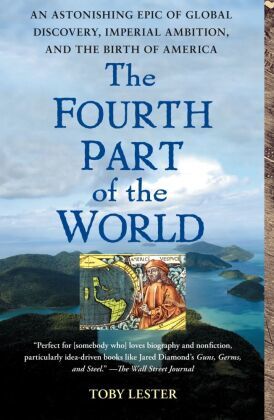The Fourth Part of the World - An Astonishing Epic of Global Discovery, Imperial Ambition, and the Birth of America
| Verlag | Simon & Schuster UK |
| Auflage | 2010 |
| Seiten | 496 |
| Gewicht | 448 g |
| Artikeltyp | Englisches Buch |
| ISBN-10 | 1416535349 |
| EAN | 9781416535348 |
| Bestell-Nr | 41653534UA |
Seit Jahrtausenden glaubten die Europäer, dass die Welt aus 3 Teilen bestünde: Europa, Afrika und Asien. Nur hin und wieder munkelte man von einem vierten Kontinent. Ein mysteriöses Land, unerreichbar durch einen riesigen und nicht bezwingbaren Ozean, ein Mythos. Im Jahre 1507, Columbus war ein Jahr zuvor in dem Glauben verstorben, Asien bereist zu haben, kamen zwei Gelehrte, Martin Waldseemüller und Matthias Ringmann, nach der Lektüre Amerigo Vespuccis Entdeckungen, zu dem Schluss, dass Vespucci tatsächlich den vierten Kontinent bereist haben muss, und druckten zu dessen Ehren eine Weltkarte. Und sie benannten den vierten Kontinent nach ihm: Amerika. Die spannende Geschichte der 'Waldseemüller Weltkarte'.
Klappentext:
"Old maps lead you to strange and unexpected places, and none does so more ineluctably than the subject of this book: the giant, beguiling Waldseemüller world map of 1507." So begins this remarkable story of the map that gave America its name.
For millennia Europeans believed that the world consisted of three parts: Europe, Africa, and Asia. They drew the three continents in countless shapes and sizes on their maps, but occasionally they hinted at the existence of a "fourth part of the world," a mysterious, inaccessible place, separated from the rest by a vast expanse of ocean. It was a land of myth-until 1507, that is, when Martin Waldseemüller and Matthias Ringmann, two obscure scholars working in the mountains of eastern France, made it real. Columbus had died the year before convinced that he had sailed to Asia, but Waldseemüller and Ringmann, after reading about the Atlantic discoveries of Columbus's contemporary Amerigo Vespucci, came to a startling conclusion: Vespucci had reached the fourth part of the world. To celebrate his achievement, Waldseemüller and Ringmann printed a huge map, for the first time showing the New World surrounded by water and distinct from Asia, and in Vespucci's honor they gave this New World a name: America.
The Fourth Part of the World is the story behind that map, a thrilling saga of geographical and intellectual exploration, full of outsize thinkers and voyages. Taking a kaleidoscopic approach, Toby Lester traces the origins of our modern worldview. His narrative sweeps across continents and centuries, zeroing in on different portions of the map to reveal strands of ancient legend, Biblical prophecy, classical learning, medieval exploration, imperial ambitions, and more. In Lester's telling the map comes alive: Marco Polo and the early Christian missionaries trek across Central Asia and China; Europe's early humanists travel to monastic libraries to recover ancient texts; Portuguese merchants round up the first West African slaves; Christopher Columbus and Amerigo Vespucci make their epic voyages of discovery; and finally, vitally, Nicholas Copernicus makes an appearance, deducing from the new geography shown on the Waldseemüller map that the earth could not lie at the center of the cosmos. The map literally altered humanity's worldview.
One thousand copies of the map were printed, yet only one remains. Discovered accidentally in 1901 in the library of a German castle it was bought in 2003 for the unprecedented sum of $10 million by the Library of Congress, where it is now on permanent public display. Lavishly illustrated with rare maps and diagrams, The Fourth Part of the World is the story of that map: the dazzling story of the geographical and intellectual journeys that have helped us decipher our world.
Rezension:
"Marvelously imaginative, exhaustively researched. . . . Guiding the reader Virgil-like through the Age of Discovery, Lester introduces a chronologically and conceptually vast array of Great Men (Columbus, Vespucci, Polo, Copernicus, et al.), competing theories, monastic sages, forgotten poets, opportunistic merchants, unfortunate slaves, and more. That he relates it all so cleanly and cogently-via elegant prose, relaxed erudition, measured pacing, and purposeful architecture-is a feat. That he proffers plentiful visual delights, including detailed views of the legendary document, is a gift. This map, Lester writes, 'draws you in, reveals itself in stages, and doesn't let go.' Nor does this splendid volume."
- The Atlantic

